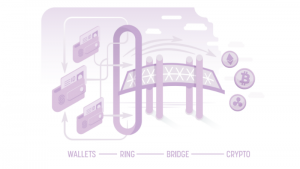
Shyft Co-founder Joseph Weinberg: “This deployment represents years of careful consideration and development by teams around the world. The next phase of our ecosystem will be based on real-world applications and solutions to problems that are fundamental to both the traditional world and the new one being built in the blockchain space today. Interoperability, the establishment of regulation as a protocol, and better standards around how we ensure privacy while enabling transparency in situations that require explicit trust are the next set of base layer requirements that our ecosystem needs to continue to permeate into traditional environments and to enable mass adoption. These are the enablements that Shyft and Byfrost are bringing to all ecosystem and public and private networks infrastructures today.”

Byfrost
Byfrost enables the creation and routing of synthetic assets across multiple blockchains as well as on-chain asset custody and management. Through its associated ERC-20 token, BFST, the bridge will support the conversion and cross-chain transfers of native tokens like:
- ETH
- RSK
- EOS.
Shyft plans for more integrations – after Byfrost’s initial deployment. Following the public code launch of Byfrost, Shyft will initiate a staged rollout of its complete Network (‘Mainnet’), with new partnerships, and developer grant programs, in three development phases:
- from the current Private Testnet
- to a public ‘Alphanet’
- to its Mainnet.
Byfrost monitors network activity in search of malicious behaviour. It has the ability to slow down or pause block validation if it detects a serious threat, such as an attempted 51% attack. It also facilitates interoperability with external networks.
On the road to Shyft Mainnet (see below), Shyft has deployed Byfrost and its associated token BFST to showcase Shyft’s bridging cross-protocol functionality for asset transfers. Byfrost acts as both a gate and gatekeeper; ambassador and guardian which:
- provides on-chain asset custody and management
- enables the creation and routing of synthetic assets across multiple blockchains
- manages the Shyft KYC smart contracts utility (the Flight Deck)
- bonds BFST ERC20 tokens to forthcoming Shyft (SHFT) native tokens
- converts native assets to and from the BFST token ledger.
Shyft
Shyft is a proof-of-sender protocol and credential verification network. Its purpose is to enable organizations, institutions, and individuals to prove and verify (in real time and at scale):
- identity credentials
- ownership rights
- credibility between counter-parties.
Shyft is a distributed, multi-layer blockchain-based network enabling users to securely obtain, store, inquire about and work with regulatory-compliant data. It seeks to:
- reduce the costs of compliance and due diligence mandates (Know Your Customer or KYC, Anti-Money Laundering or AML and Enhanced Due Diligence or EDD)
- maximise data security
- protect identities
- go beyond the capabilities of traditional non-blockchain-based compliance systems.
- make compliance becomes cheaper, faster and more secure.
Shyft also features a ‘creditability’ system. The aim is to provide consumers with a reputational score based on compliance and historical transactional activity. Such an approach has particular relevance for the unbanked.

Diego Gutierrez, CEO of Rootstock and Shyft advisor: “For many years I’ve been sharing the vision of how Bitcoin was the cornerstone of the Internet of Value, but in order to thrive, this new Internet needs upper-layer protocols that fulfil the core needs of the financial system of the future. By building an interoperable KYC between blockchains, Shyft is taking this vision one step further and facilitating key use cases like international trade and financial inclusion.”
Additionally, this release features a suite of linked smart contracts designed to enable secure and distributed KYC checks, data attestation modelling and frameworks as well as Shyft Network Trust Anchor code for multi-party data binding into the upcoming network.
The Shyft Network
The Shyft Network is a combination of:
- centralised data attestation (the ‘Shyft Bridge’)
- an expansive network of validation nodes that connect to the outside world (the ‘Shyft Ring.’)
The Shyft blockchain features a smart contract compatible architecture. Running simultaneously on the Shyft Bridge and Shyft Ring this is based on the Ethereum blockchain’s codebase with the modifications to the Ethereum consensus engine:
- all Shyft Ring nodes must forward end-user requests to the Shyft Bridge
- all Shyft Ring nodes must validate the transactions in the Shyft Ring mempool up to the defined capacity limit of the Shift Bridge
- Uncle14 generation for Shyft Ring nodes reward on a granular depreciating basis dependent on the active
- computing power of the Shyft Ring node (other incentives may come later)
- all Shyft Ring nodes must process any end-user transactions, and immediately signal and provide proof to the network of malicious actor activity (for example, attempts to double spend).
All other aspects of the Shyft Network’s primary security models closely follow the Ethereum model. As the Ethereum codebase evolves, Shyft says it will incorporate technical changes to improve its network.
Enterprise Times: what does this mean
Recent developments in financial technology are increasingly requiring finance sector participants, including regulatory bodies, to adapt. If they do not, they risk disruption and/or catastrophic failures (q.v. the threat of immense fines for terrorism financing). In consequence compliance obligations for financial institutions are increasing in number, complexity and rigour required.
At the same time the costs of satisfying such obligations rise and rise. Anything less than strict compliance can result in significant legal penalties and/or reputational damage:
- for major banks and large financial institutions, compliance represents an increasing drain on resources
- for smaller institutions, compliance can stifle basic operations.
In effect, compliance has become a business threatening requirement. Without it fines may drive a business to the wall. But satisfying regulators has significant costs with practical implications.
The Shyft Network wishes to offer solutions which remove these risks. While not disputing the underlying basis for the Shyft Network proposition, the need for tokens remains a concern for Enterprise Times (see the BIS view). Whether this Enterprise Times concern will outweigh finance sector needs remains an open question.

























